Cherry Blossoms, Moonlight, and Coca Cola: Subversions of Mono no Aware in Japanese New Wave Cinema
Jamie Kojiro
Carnegie Mellon University – Japanese Studies
Introduction
Going all the way back to the Tale of Genji and the beginning of Japanese literature, Japanese art frequently incorporates the aesthetics of mono no aware, or the “transcience of things”. The use of the mono no aware aesthetic continues into Japanese film, in particular during the classic film era of the 1930s under directors like Ozu Yasujiro. Ozu is largely considered Japan’s “most Japanese” film director, and it can be argued that his continuation of the mono no aware tradition contributes to this reputation. After World War II and the American Occupation, however, the nation’s youth felt disillusioned with traditional Japan, and I argue this disillusionment translated into a rejection of mono no aware in the Japanese New Wave film movement of the 60s.
In the 50s and 60s, film studios promoted many young people to the status of directors in order to save the film industry, which suffered from the invention of television and the migration of people to the suburbs (Desser 9). These young film directors pioneered an avant-garde film movement: the Japanese New Wave. Besides visually challenging the norms of the typical Hollywood film, these New Wave films produce politically challenging narratives addressing prominent social issues of the time, often with leftist intentions. This essay argues that New Wave directors purposefully create tension between their films and the narrative expectations of mono no aware in order to criticize the political status quo; while directors like Ozu incorporated mono no aware into typically conservative narratives, the young New Wave directors subvert the traditional understanding of mono no aware in order to express their political discontent.
Background
New Wave filmmakers felt anxiety and discontent about the political direction of 50s and 60s Japan, in particular regarding the rise of capitalism and the return to Japanese militarism. Young political activists from the New Wave generation lead Japan’s leftist movements, forming communist, socialist, and labor union movements (Desser 31). College students in particular formed student groups to participate in both protests and direct action (Desser 31). Their political activism permeates New Wave film, both directly and indirectly. In Fugitives from the Past (directed by Nagisa Oshima), scenes taking place in Tokyo portray the main characters pushing through crowds of student protesters. Although they ignore the protests and the film never directly addresses them, Oshima contextualizes the characters’ interpersonal conflict within the political conflict and raises questions about the political state in Japan; while the inspector refuses to buy rice from the black market, and therefore his children are underfed, the fugitive, Inukai, and Yae, an accomplice, use stolen money and the black market to improve their lives and ability to survive. Alternatively, Night and Fog in Japan deals explicitly with a real-world political event: the signing of the United States-Japan Security Treaty of 1951. The treaty “recognized ‘Japan’s right to individual and collective self-defense’... by which U.S. forces remained in Japan until the Japanese secured their own defense”(Britannica). Young activists heavily protested the signing of this treaty, seeing many social and political problems arising, according to Pempel’s analysis, as “a consequence of the US Occupation’s reverse course and the return to power of the spiritual heirs of those who had led Japan through the tragedies of the 1930s and 1940s”(qtd. in Desser 33). The generation of New Wave filmmakers was, therefore, discontent with how Japan ignored the consequences of its political past.
The New Wave’s active political discontent operated at odds with the aesthetic of mono no aware which preached to find beauty in accepting inevitability. Norinaga, one of the earliest to define mono no aware, writes:
“Aware” originally signified the sighing voice felt in and emitted from the heart when one sees, hears, or otherwise touches some object in the world, and as such is no different from the interjections ‘ah’ and ‘hare’ of our common colloquial speech. For example, when we are moved upon the sight of cherry blossoms or the moon…(qtd. in Meli 64).

An example of mono no aware can be found in cherry blossoms. Image source: https://www.peakpx.com/en/hd-wallpaper-desktop-apmfd
The heart sighs not merely in response to any beauty, but specifically to a natural, transient, and somewhat sorrowful or nostalgic form of beauty. To know mono no aware means to understand and accept transience. Bond writes,
That is precisely the unique appeal of the cherry blossoms; their aesthetic focuses on the unavoidable transience of the material world that exists. According to this view, the fragility and inherent brevity of an instance of awe, such as the blooming of the cherry blossoms, only aids in heightening the event’s stunning, albeit melancholic nature
Mono no aware is not merely an aesthetic, however, but also a philosophy. Meli writes, “Norinaga makes a normative claim in his theory on mono no aware: knowing mono no aware is not merely an ‘is’ (or a ‘was’); it is an ‘ought.’ If we are to know it today, claimed Norinaga, our hearts will be purified, and we will know the upright way of the ancients”(Meli 61). Mono no aware does not, therefore, merely observe or react to an event; it dictates morality and prescribes an emotional and philosophical response to the onlooker. The past, this philosophy argues, should be released and forgotten. The mono no aware philosophy is therefore at odds with the New Wave’s understanding of a political present deeply influenced by the nation’s problematic past.
The conservatism of mono no aware can be clearly illustrated in the classic era of Japanese film from the 30s. Ozu, who exemplifies the classic film era (Desser 17), produces films full of aware. One way Ozu evokes feelings of mono no aware is to obscure causality, making it so “the order of the scenes is not dependent on the preceding scene”(Desser 17). Furthermore, he eliminates climactic moments. For instance, if the film revolves around a parent’s desire to see their child married, then “we will never see anything like a wedding ceremony, the culmination of the narrative desire”(Desser 18). The central conflict of the film, then, remains unresolved in favor of mono no aware: “One savors the [interrelated feelings of love, loneliness, loss, and sadness] and overcomes it in the very recognition of inevitability”(Desser 19). Desser argues that this use of mono no aware is inherently conservative because it mythologizes history. By obscuring cause and effect, Ozu’s use of mono no aware presents history as “an endless cycle of life-death-rebirth— rather than as the product of economic, social, and political forces”(Desser 20). In rejecting climactic moments and narrative resolutions, Ozu encourages, “a disbelief in the validity of individual action, a devaluation of the idea of change”(Desser 20). Thus, the conservatism of mono no aware is at odds with the leftism of the New Wave.
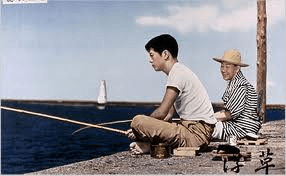
In Ozu’s Floating Weeds, a father attempts to build a relationship with his son one Summer, but ultimately fails and returns to life as a traveling Kabuki actor. Image Source: http://www.classicartfilms.com/floating-weeds-1959
New Wave Visuals and mono no aware
Visually, one way some New Wave films reject mono no aware is through references to pop art. Evoking pop art, Masumura’s Giants and Toys utilizes intense, over-saturated colors. Suzuki’s Tokyo Drifter, similar, uses brightly colored monochrome backgrounds. While aware typically references objects found in nature, such as cherry blossoms, the bright colors of pop art evoke technology and artificiality. Furthermore, while a central philosophy of mono no aware is the beauty found in transience, pop art explicitly challenges transience. The brightly colored artificiality of Giants and Toys and Tokyo Drifter suggests the inability to decay— the films create a sense of perpetual modernity and false immortality. While mono no aware suggests life is naturally transient, Suzuki and Masumura’s use of pop art suggests that capitalism and modern Japanese politics make mono no aware an outdated philosophy and unachievable aesthetic.
Pop art in New Wave films comments on the mass object and universality produced under capitalism, which erases individualism and thus the possibility of mono no aware. This can be seen in the repeated motif of the photographs in Giants and Toys. As part of their advertisement, Goda, who runs the caramel company, leads a marketing strategy of photographing an ordinary young woman. It is not the woman herself that the company cares about, but her rather her preservation in photography: “Goda understands that to make is to discover, and that she will be ‘made’ in the process of being photographically reproduced”(Roberts 134). The film shows her colorful, hypersaturated photos blown up, duplicated, and then multiplied again. This, Roberts writes:
becomes a cipher for the process of massification and reification…The mass object is always general, never particular, its universality serving to close the distance with a mass audience. This is the underlying import of Warhol’s famous statement about Coca-Cola, that archetypal mass object: “All the Cokes are the same and all the Cokes are good.”(Roberts 135-136).
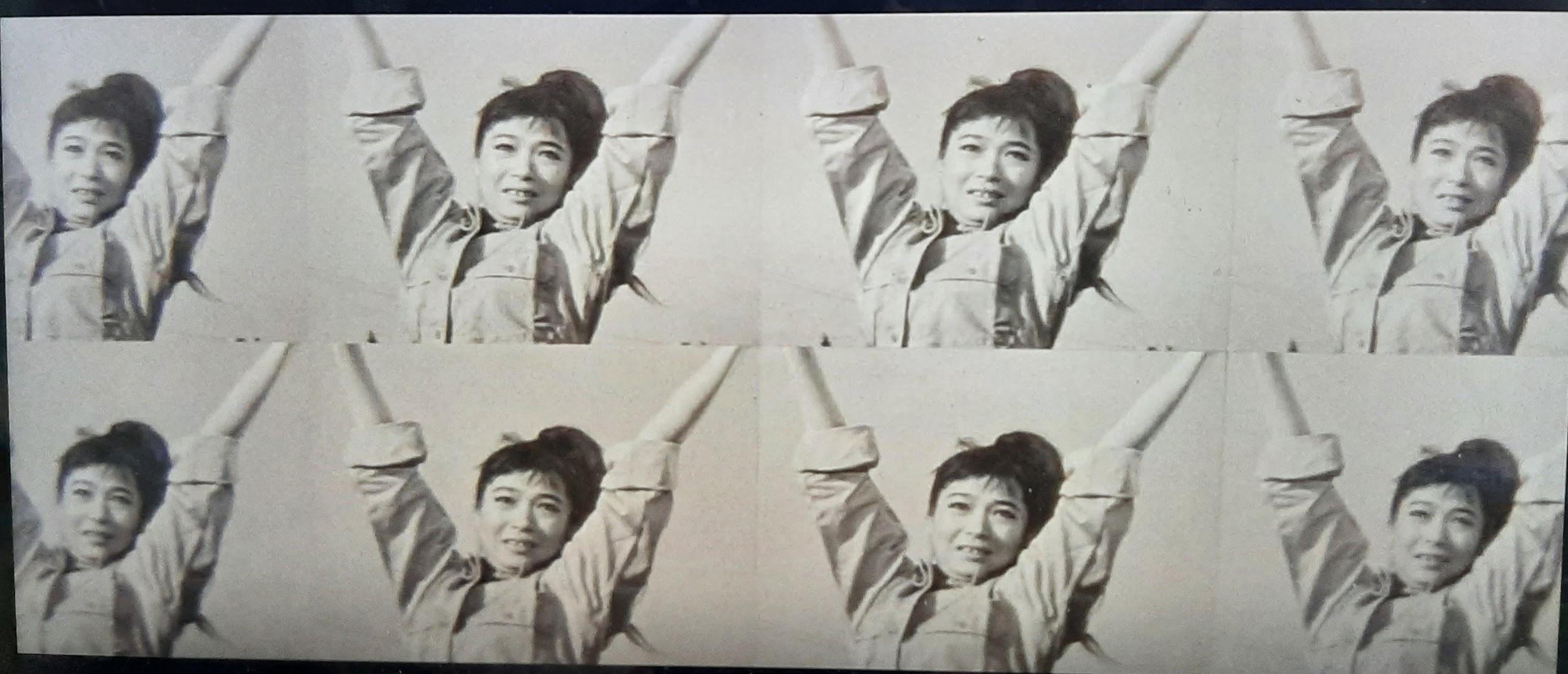
The Warhol-like opening scene of Giants and Toys. Image Source: Itune Video
When all things are the same (and all are good), mono no aware cannot be possible because nothing is temporary— capitalism is ever-present and all-encompassing. Masumura, through the narrative of the young woman, criticizes the rise of the mass object and satirizes the erasure of mono no aware in Japanese culture: the philosophy that one ‘ought’ to embrace mono no aware in order to find peace, the film suggests, is a non-solution due to the elimination of aware in modern society.
Nonetheless, protagonists seek out transcience and attempt to escape the past; New Wave film draws attention to the superficial and futile quality of these attempts by using the pop art visual style. The clean lines, monochrome, and two-dimensionality of pop art represent the effort to portray complex realities as cleaner and simpler. Seen in Night and Fog in Japan, the narrative jumps back and forth between the past and the present. The past takes place in dynamic settings as characters face complicated political and personal conflicts. The wedding scene, however, continues to return to the same tableau: the bride and groom stand upright, professors on either side of them, against a monotone background. Centered on the table in front of them stands a white cake with bright, artificially dyed green and red fruit. The scene, evoking pop-art visuals, creates a veneer of strict politeness and demand for celebration. The stillness and 2-dimensionality, however, draw to attention the hollowness of the ceremony. Despite being a wedding, everyone feels posed and wears somber expressions.
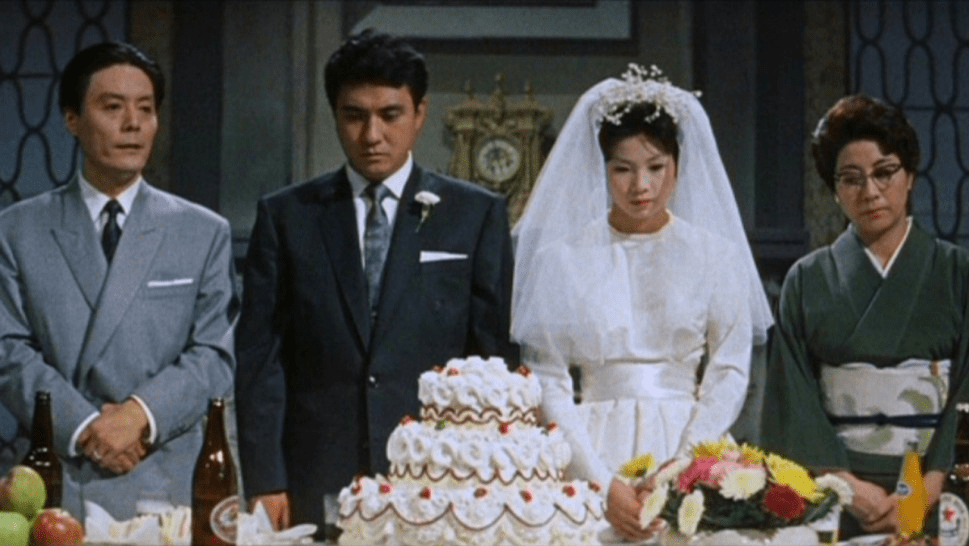
The marrying couple in Night and Fog in Japan. Image Source: https://harvardfilmarchive.org/calendar/night-and-fog-in-japan-2008-12
Reality reasserts itself onto the scene, breaking the pop art tableau, when characters from the couple’s past (including a drunk friend claiming to be possessed by a ghost) burst into the room and, with their impassioned monologues, switch the narrative into flashback. New Wave thus uses the artificiality of pop art to criticize the mono no aware tendency to treat history as mythology rather than an ongoing political reality.
Although there is a cyclical or seasonal element to aware (cherry blossoms, after all, return each year), the past in the New Wave does not naturally disappear in an ebb and flow cycle—the past looms, it intrudes— one way New Wave directors show the past intruding on the present is through sweeping camera movements that suddenly bring the off-screen into the on-screen, thus de-emphasizing diegesis. In the Night and Fog wedding scene, when the unexpected guests barge into the room, instead of using controlled pans or cutting between speakers, the camera rapidly sweeps around the room, interrupting the static pop art tableau. Dana Polan writes, “Here when off-screen becomes on-screen space through movement of the camera… Against the symmetry of the wedding which tries to deny history, the camera-movement serves as a figure for the movement, the changeability of historical reality”(qtd. in Desser 29). Fugitives from the Past also use uncontrolled camera movement to show what the protagonists choose to ignore:
In one key moment, for instance, Detective Yumisaka is dispatched to the streets of the capital yet seems unable to command any controlling perspective on his environs in his search for the missing figure of Yae. Instead it is Uchida's mobile camera that uncovers a wider conception of Japan's disordered postwar society, into which she has apparently disappeared(Phillips).
This emphasis on the camera’s mobile perspective over the protagonists’ static point of view forces the viewer to engage with the past that the characters refuse to engage with; unlike the conservatism of mono no aware which suggests the past will fade on its own, the camera demonstrates the complete hold that the past has on the present even if people try to forget.
New Wave Themes and mono no aware
New Wave films heavily criticize the return of Japanese militarism; unlike the transient, life-death cycle of aware, New Wave films portray a past that refuses to stay dead, haunting the protagonists. Masamura subtly suggests the continuation of Japan’s militarism in an advertising battle in Giants and Toys, during which “Masumura shows [the publicity tactics] as war tactics, the metaphor being literalized in the rapid montage sequence showing the ‘triangular publicity battle’’(Roberts 138). This sequence shows, for example, companies dropping pamphlets from helicopters to promote their product. Thus, alongside satirizing and criticizing capitalism, Masamura furthermore suggests the continued influence of the war prevents transience. Thematically, the past can be seen catching up to Nishi when he must don the spacesuit at the end of the film. Rather than break away from the cyclical past created by his company, despite his best efforts to escape he becomes trapped. The spacesuit symbolizes the role of America in trapping Japan in its past. The company chooses the spacesuit as part of its marketing strategy because of space travel’s association with America. Just as young activists argued the Anpo treaty would cause problems for Japan, partially by giving power back to the Japanese militarism of the 30s and 40s, the company’s allegiance with American ideas and aesthetics perpetuate the problems of Nishi’s past, prevent his escape from the company, and thus make impossible mono no aware.
The inability to escape the past can further be illustrated by New Wave’s affinity for film noir and gangster movies. In Fugitives from the Past, a film noir, the fugitive Inukai changes his name, cleans up his appearance, and reinvents himself as a respected businessman. The film warns, however, through the frightening monologue of a possessed medium, that there are “Seven ways to hell but no way to come back”(Fugitives from the Past). It is, in fact, Inukai’s desperation to avoid and erase the past that leads to his ultimate downfall. When his ex-lover, Yae, finds him and seeks to thank him, he panics at his discovery and kills her. The rain and thunderstorm outside the window calls back to the moment the ghost warned him, and thus the ghost of his past catches up to him. The resulting investigation leads to his arrest and suicide. Phillips argues that Inukai’s attempt to clean himself up and erase his past criticizes Japan’s own attempt to forget the war rather than address the past properly. He compares Inukai’s transformation to historian Igarashi Yoshikuni’s analysis of postwar Japan. For Igarashi, postwar Japan:
“... [erased] its own struggle to deal with its memories … it involved a constant struggle to render memories of war into a benign, nostalgic form. When the historical process of forgetting itself became erased, the experiences of loss in war were buried within postwar society.” Thus, according to Igarashi, “in order to remember the past, this process of forgetting has to be brought to consciousness”(Phillips).
New Wave film protagonists frequently try to erase and forget their pasts without fully addressing them. In mono no aware, the past fades on its own with a beautiful feeling of sorrow, with an “ah” or a “hare.” But when New Wave protagonists wait for the past to die, it instead remains ever-present in their lives, and their attempts to move on lead to their tragic ends.
Unfulfilled Promises
Although New Wave films criticize the passivity of mono no aware, the characters and audience alike long for it still, demonstrating the role of mono no aware as an unfulfilled promise. In Giants and Toys, Nishi tries to escape from the overwhelming environment of pop art, and its persistence creates the tragedy:
Often, a swish pan is used to illustrate a moment of dramatic irony. In the scene at the beach, for example, Nishi has taken Masami to the ocean, giving us an initial impression of flight from the oppressive atmosphere of the corporate workspace. A vertical swish pan shows us that in fact Nishi and Masami are parked directly in front of a billboard for World candies. There’s been no escape (Meli 140).
This scene teases the audience with the promise of mono no aware found in a transient afternoon by the ocean. Meaningful access to aware would improve Nishi’s life as it would mean a genuine way to escape capitalism and let the past float away. The tragedy of the film, then, is precisely this lack of access to mono no aware. Similarly, Fugitives from the Past, Oshima utilizes a repeated motif of travel and public transportation, showing trains, busses, and the train and bus stops of all the locations, all hinting at the transient quality of mono no aware. The characters themselves long for transience: Yae longs to move on from her old life to gaining honest work, Inukai wants to escape his criminal past, and the investigator wants closure to his old investigation. The ending, wherein Inukai throws himself into the ocean, is the closest thing to a happy ending as the film can provide as it is the only way Inukai can lay the past to rest. This scene evokes mono no aware in its visuals of the ocean and the passing of Inukai’s life. Fugitives of the Past turns this scene tragic, however, by suggesting Inukai should not have had to die to achieve the aesthetics of mono no aware. The inspector offers Inukai flowers to throw into the sea to morn the death of Yae, thus letting go of the past in a scene evocative of mono no aware. Doing so, however, would condemn Inukai to a life in prison, thus forcing himself to throw himself into the sea instead. To move on from the negative repercussions of the past, these films argue, is desirable but unachievable. Mono no aware, then, becomes a bitter, unfulfilled promise.
New Wave film links the unfulfilled aesthetic of mono no aware to the unfulfilled promises made in Japanese politics and economics. Teshigahara’s Woman in the Dunes subverts a traditional mono no aware narrative to create an existentialist narrative expressing the unfulfilled promises of capitalism. In the film, a man finds himself trapped by a strange woman to whom he must marry. In order to survive, every day he must spend all day digging sand out of the hole they live in in the desert. In many ways, this story calls upon the recurring mythical trope of the spirit bride (portrayed in films such as The Mad Fox and Kwaidan). In the myth, a man marries a beautiful woman belonging to the spirit world. The marriage, though, is conditional on following certain rules. The man eventually becomes careless and breaks the rules, and the spirit bride disappears. This recurring myth strongly calls upon the aesthetics of mono no aware and the sorrowful beauty of the marriage. Woman in the Dunes, however, inverts the myth because despite deliberately breaking the rules through choosing not to shovel sand, the marriage persists. Teshigahara connects the existentialist narrative to anti-capitalist ideology when the protagonist wonders aloud if he shovels sand to live, or lives to shovel sand. Teshigahara furthermore comments on capitalism when the protagonist realizes his employer, whom he is convinced will notice his absence and send people to find him, fail to appear. Just as traditional Japanese narratives promise transience and thus mono no aware, capitalism promises meaningful rewards in exchange for labor. Teshigahara and other New Wave filmmakers criticize Japan’s unfulfilled promises by deliberately calling upon mono no aware and then subverting it.
Suzuki’s Subversion
That is, most New Wave films leave mono no aware an unfulfilled promise; while New Wave films typically end cynically, offering no solutions to the political issues they unearth, Suzuki Seijun’s Tokyo Drifter suggests aware can come to fruition by directly confronting the problems with American imperialism and traditional Japanese militarism. The narrative for Tokyo Drifter follows Tetsu, a young yakuza, who is on the run after taking the fall for a murder on behalf of his boss. Tvorun-Dunn argues that Tetsu’s boss represents traditional Japan, visually symbolized by muted earth-tones and textually indicated by his value of loyalty and total commitment to a cause, a value Tetsu strongly upholds (138). The rival gang, alternatively, represents modernity and American imperialism as represented by their pop art colors, the American music they play, and American comic books they read (138).
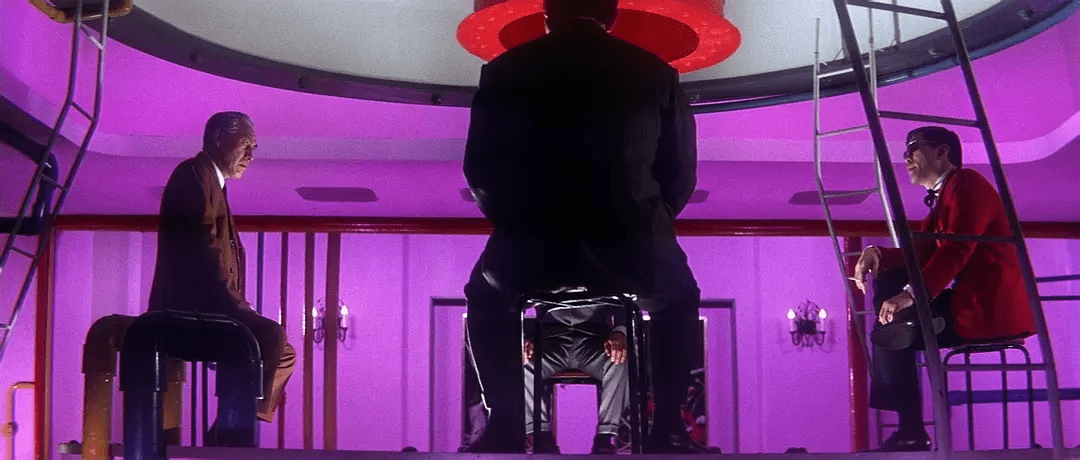
Tetu’s boss (left, in the brown suit) meets with the rival gang. Image source: https://www.imdb.com/title/tt0061101/
While on the run, Tetsu’s boss teams up with the rival gang and betrays him. The subsequent fight scenes represent Tetsu fighting, and overcoming, both traditional Japan and Westernized Japan. The first fight scene in Shonai, Tvorun-Dunn argues, represents traditional Japan, as all the architecture is traditional and it is mainly older weapons, not guns, that are used in the fight (140) whereas the second major fight scene, taking place in a Western saloon and mimicking the chaos of a cowboy Western bar fight, represents Western influence (141). Tetsu wins both these fights. The film concludes with a final fight scene set against an all-white background. Tvorun-Dunn argues that the final fight scene is a fusion of both Western and traditional, calling upon the meticulousness of the traditional fight scene in the careful staging as well as the quick-draw motif of the cowboy Western (Tvorun-Dunn 143).
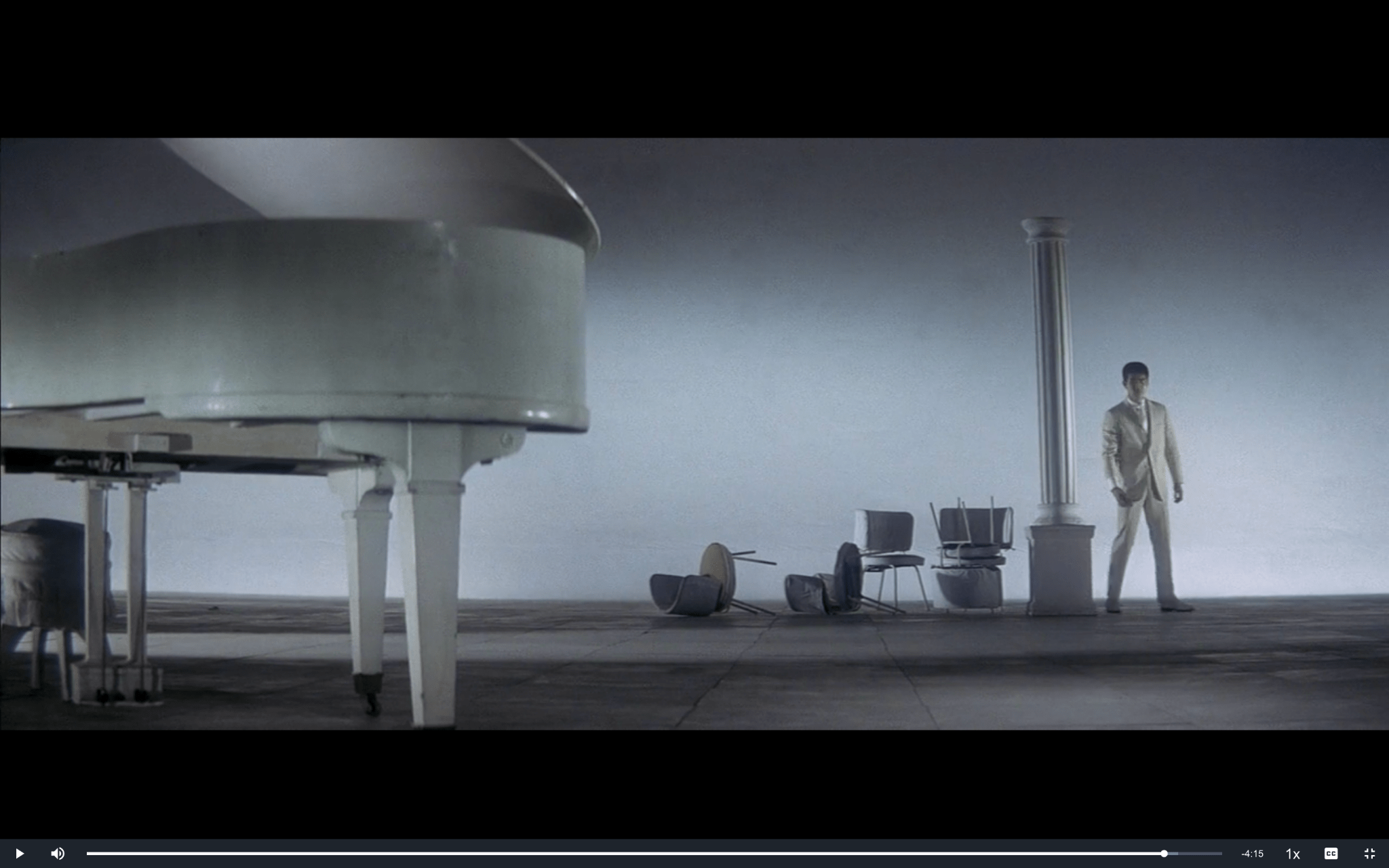
Tetsu steps out into the open, preparing to quick-draw on the enemy gang members. Image source: https://cmu.kanopy.com/video/tokyo-drifter
In the end, Tetsu defeats both bosses. As he walks away, he chooses to continue wondering Tokyo. The repeated musical motif of the song “Tokyo Drifter” exemplifies mono no aware. In a melancholy tune, Tetsu sings about drifting from place to place, without a home. In this way, Suzuki argues that Japan must directly confront the contemporary political issues, rejecting the return to Japanese militarism and the influence of American imperialism. Just as Tetsu’s confrontation with his past allows him to know mono no aware, avoiding a tragic ending, Tokyo Drifter argues that political action will allow Japan’s past to be resolved and create a way forward for the future.
Conclusion
Amidst the widespread discontent of the New Wave generation, the classic portrayal of mono no aware would have felt meaningless and, ultimately, conservative, but by subverting the expectations of mono no aware, New Wave filmmakers create politically leftist films calling for political action and confrontation of the past. Unfortunately, most New Wave filmmakers were ultimately deemed too radical for continued employment by the studios, either due to their challenging aesthetics, as with Suzuki, or due to their politically radical stances, as with Oshima. Although some New Wave filmmakers continued to make films using their own production studio, the movement eventually died out towards the end of the 60s. Desser argues a political reason for this: “the political goals which gave life to the movement came to seem increasingly out of reach, mirroring the shift in quality and quantity of political activity at the end of the ‘60s”(10). However, though the movement was short-lived, the New Wave created a powerful and sophisticated dialogue with the mono no aware of the past which should not be overlooked. In creating these subversions, filmmakers demonstrated how narrative form and politics can be intrinsically linked, and moreover, demonstrated how to effectively manipulate aesthetic expectations to create powerful social commentary.
Work Cited
A Fugitive from the Past. Directed by Tomu Uchida, TOEI, 1965.
Bond, Taylor. "Mono no Aware: The Transience of Life." (2017).
Desser, David. Eros plus massacre: An introduction to the Japanese new wave cinema. Vol. 469. Indiana University Press, 1988.
Giants and Toys. Directed by Yasuzo Masumura, Daiei, 1958.
Meli, Mark. “Motoori Norinaga’s Hermeneutic of Mono No Aware: The Link between Ideal and Tradition.” Japanese Hermeneutics: Current Debates on Aesthetics and Interpretation, edited by MICHAEL F. MARRA, University of Hawai’i Press, 2002, pp. 60–75, http://www.jstor.org/stable/j.ctt6wqv8m.11.
Night and Fog in Japan. Directed by Nagisa Ōshima, Shochiku, 1960.
Phillips, Alastair. "Fractured landscapes: detection, location and history in Uchida Tomu's Kiga kaikyo/A Fugitive from the Past." Screen 52.2 (2011): 215-232.
Roberts, Mark D. Masumura Yasuzô and the Cinema of Social Consciousness, University of California, Berkeley, Ann Arbor, 2007. ProQuest, https://www.proquest.com/dissertations-theses/masumura-yasuzô-cinema-social-consciousness/docview/304901012/se-2?accountid=9902.
Tokyo Drifter. Directed by Seijun Suzuki, Nikkatsu, 1966.
Tvorun-Dunn, Maxim. (2020)"Finding Identity through Style: Seijun Suzuki’s Tokyo Drifter." Japan beyond Its Borders: Transnational Approaches to Film and Media (pp. 133 - 145). Birkbeck Institutional Research Online.
Woman in the Dunes. Directed by Hiroshi Teshigahara, Teshigahara Production, 1964.
“International Relations.” Encyclopædia Britannica, Encyclopædia Britannica, Inc., https://www.britannica.com/place/Japan/International-relations.